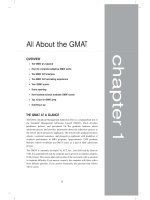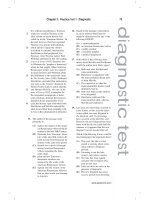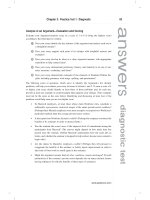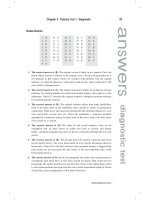Master gmat 2010 part 34 doc
Bạn đang xem bản rút gọn của tài liệu. Xem và tải ngay bản đầy đủ của tài liệu tại đây (45.72 KB, 10 trang )
P
ART V
GMAT VERBAL SECTION
CHAPTER 12 Critical Reasoning
CHAPTER 13 Sentence Correction
CHAPTER 14 Reading ComprehensionCritical Reasoning
OVERVIEW
• The 6-step plan
• Assumption questions
• Additional evidence questions
• Inference questions
• Strategy questions
• Hypothesis questions
• Necessary inference questions
• Parallel argument questions
• Summing it up
In this chapter, you’ll:
• Briefly review the basic terminology you need to know for GMAT
Critical Reasoning
• Learn a step-by-step approach to handling any Critical Reasoning
question
• Learn how to recognize and handle each of the three basic, and most
common, types of Critical Reasoning questions
• Learn success keys for tackling Critical Reasoning questions
THE 6-STEP PLAN
The first task in this chapter is to learn the six basic steps for handling a
GMAT Critical Reasoning question. You’ll apply these steps to the following
sample question:
Among customers of breakfast restaurants, more order fresh fruit
for breakfast than any other menu item. However, a recent health
chapter 12
315
research report indicates that eating eggs does not pose as significant a health risk
as previously thought. In response to this report, operators of breakfast restaurants
should increase the number of eggs but decrease the amount of fresh fruit they
order from their suppliers.
1. Which of the following, if true, would be the best reason to reject the recommenda-
tion made in the argument above?
(A) Eating eggs still poses a substantial health risk, especially for males over
age 50.
(B) Most fresh fruits are available only seasonally, whereas eggs are available any
time of the year.
(C) Alternatives to breakfast egg dishes, such as pancakes and cereals, are growing
in popularity at breakfast restaurants.
(D) Many customers of breakfast restaurants who order eggs also order fresh fruit.
(E) Compared to fresh fruits, pre-prepared fruit juices are growing in popularity
among people who dine at breakfast restaurants.
Step One: Read the Question “Stem”
Reading the question stem (the actual question or prompt that follows the passage) first will
tell you what you should think about as you read the passage. Be sure you understand the
specific task that the question is asking you to perform.
Step Two: Read the Passage and Identify Its Key Elements
Identify the argument’s conclusion (if any) and its premises. If the passage contains a
conclusion (most Critical Reasoning passages do), try to follow the argument’s line of
reasoning from premise(s) to conclusion. To help yourself along, try reading the passage
again, starting with the conclusion. (Critical Reasoning passages are brief, so a second
reading won’t take much time.)
Step Three: Try to Formulate Your Own Answer to the Question
Once you’ve determined exactly what the question is asking you, try to come up with your own
answer before reading the given answer choices.
Step Four: Read the Five Answer Choices for the “Best” Response
Look for the answer choice that is similar to one of the “best” answers you’ve formulated. But
don’t assume that your home-grown best answer will look exactly the way you imagined it.
Instead, look for a choice that conveys the same general idea. Also, keep an open mind to a
possible “best” answer that hasn’t yet occurred to you.
Step Five: If You’re Still Not Sure, Eliminate Choices
Eliminate choices that make no sense to you, that don’t seem directly relevant to the
argument, or that accomplish just the opposite of what the question asks for.
316 PART V: GMAT Verbal Section
www.petersons.com
Step Six: Compare the Quality of the Remaining Answer Choices
Try to determine which is qualitatively better than the others. Don’t try to make ultrafine
semantic distinctions, parse words, or second-guess the test makers. The qualitative
difference between the best and any runner-up choice will be clear enough—if your thinking
is straight.
Now let’s walk through the sample question about breakfast restaurants, using this 6-step
approach.
Step 1: This question stem tells you quite a bit about the passage as well as what to look for
in a viable answer choice. The stem essentially asks you to recognize how the argument can
be weakened. Since it refers to the “argument above,” you know that the passage will contain
at least one premise (information that you should assume is factual) as well as a conclusion,
which, in this case, will be in the form of a “recommendation.”
Step 2: The passage’s last sentence expresses the argument’s conclusion, while the first two
sentences indicate the premises on which the conclusion is based. So what’s the line of
reasoning here? In other words, what’s the logical connection between the premises and the
recommendation? Apparently, the passage’s author thinks that breakfast restaurant
customers now know that it’s okay to eat eggs, so a significant number will begin ordering
eggs instead of (as a substitute for) fresh fruit; based on this reasoning, it would make sense
for restaurants to get ready for the shift in demand toward eggs and away from fresh
fruits—by adjusting their supplies accordingly. If you find this line of reasoning a bit
questionable—in other words, if you think it’s full of holes—you’re on the right track. Proceed
to Step 3.
Step 3: The question essentially asks how you’d weaken the argument. So now’s the time to
critique it—to shoot some big holes in it. Ask yourself what else is needed to justify the
recommendation, based solely on the premises. Doesn’t the logical leap from premises to
conclusion rely on certain assumptions about a significant number of breakfast restaurant
patrons? Here are three such assumptions (have any of these occurred to you?):
Customers are actually aware of the report (otherwise, why anticipate increased
demand for eggs?).
Customers would prefer eggs over fresh fruit, even if they knew about the report
(otherwise, why anticipate a shift in demand from fresh fruit to eggs?).
Customers consider eggs a suitable substitute for fresh fruit (otherwise, why de-
crease the supply of fresh fruit?).
Any one of these assumptions would form a good basis for a “best” answer to the question. To
draft that best answer, all you’d need to do is refute any one of those assumptions—in other
words, point out that any of the following is true:
• Customers are not aware of the report.
• Customers would not prefer eggs over fresh fruit (even if they knew about
the report).
• Customers do not consider eggs a suitable substitute for fresh fruit.
Chapter 12: Critical Reasoning 317
www.petersons.com
Step 4: Notice that the statement in choice (D) (Many customers of breakfast restaurants who
order eggs also order fresh fruit) is not quite the same as saying that eggs are not a substitute
for fresh fruit (the last of our home-grown answers from Step 3). Yet, the essence of the
critique is essentially the same: It’s unfair to assume, without any supporting evidence, that
a significant number of customers are going to switch from fruit to eggs. Notice that (D) uses
the word “many,” leaving open the possibility that for some customers these two choices might
be mutually exclusive. So does that mean that there’s probably a better answer choice? No; it’s
a pretty safe bet that (D) is the best choice. But go ahead and consider the other choices,
anyway, just in case. Tentatively earmark (D) as your selection, then continue to Step 5.
Step 5: Consider each of the other four answer choices in turn:
Choice (A) also tends to weaken the argument. (If eating eggs is risky, this fact would tend to
discourage, rather than encourage, people from eating them.) But if (A) is to significantly
weaken the argument, we need to assume that a significant percentage of breakfast
restaurant customers are males over the age of 50. Since (A) depends heavily on this
additional assumption, it is not as effective as (D) in weakening the argument. Earmark it as
a “runner-up.”
Choice (B) is difficult to assess without more information, isn’t it? The fact that fresh fruits
are seasonal might have a bearing on whether owners should decrease their fruit supplies at
a particular time. (For example, you could argue that, when fresh fruit is plentiful, lowering
the supply might be safer than when it is not.) But what does that have to do with increasing
egg supply? Absolutely nothing. As you can see, it’s a real stretch to defend (B) as directly
relevant to the argument at all, let alone as a statement that would clearly weaken the
argument.
Choice (C) provides a reason why restaurant owners might want to decrease their supply of
eggs. So (C) does tend to weaken the argument. But (C) helps refute only half of what the
argument recommends. What about the recommendation to decrease fresh fruit supplies?
Whether alternatives to eggs are gaining in popularity has no clear relationship on the
demand for fresh fruit. So earmark (C) as another “runner-up.”
Choice (E) provides a reason why restaurant owners might want to decrease their supply of
fresh fruit—which is part of what the argument recommends. So (E) actually tends to
support, or strengthen, the argument—just the opposite of what you’re looking for in the best
choice. Eliminate (E).
Step 6: Reflect again on the three most viable choices—the ones that tend to weaken the
argument. Notice that choices (A) and (C), the two runners-up, both pale in comparison to (D)
in terms of how seriously they weaken the argument. You can confidently confirm your
selection: the correct answer is (D).
In this question, note that the difference between (D), the best choice, and the two runner-up
choices, (A) and (C), is just the degree of qualitative difference that’s typical of the GMAT. On
the actual exam, you won’t need to make judgment calls that are any closer than the ones
we’ve made here.
318 PART V: GMAT Verbal Section
www.petersons.com
ASSUMPTION QUESTIONS
In an assumption question, the passage will contain a series of premises and a conclusion.
However, in order for the argument’s conclusion to be probable, at least one additional
premise must be assumed. In other words, the argument will rely on at least one assumption.
Your task is to identify which of the five answer choices indicates an assumption. Think of the
structure of the argument this way:
Argument: stated premise(s) 1 assumption → inference (conclusion)
You know you’re dealing with an assumption question when the question stem looks
something like one of the following (a question stem might refer to specific passage
information as well):
“The argument in the passage depends on which of the following assumptions?”
“Which of the following is an assumption that enables the conclusion above to be
properly drawn?”
“The conclusion drawn in the first sentence logically depends on which of the
following assumptions?”
How to Identify an Argument’s Assumptions
To identify an argument’s assumptions, always ask yourself this question:
“In addition to the stated premises, what must be assumed as factual to justify the argument’s
logical leap from premises to conclusion—for the conclusion to be probable?”
Try asking and answering this question for Arguments 1 and 2 below. For each argument, try
to think of at least one or two assumptions, then jot them down on paper. (On the GMAT,
premises and conclusions are not labeled as they are here.)
Argument 1
Premise: More new Jupiter Motors automobiles were sold this year than any
other brand.
Premise: Jupiter Motors automobiles have the lowest sticker prices, which are the
manufacturers’ suggested retail prices, of any new automobiles on the market.
Conclusion: Consumers rank low purchase price as the most important factor when
purchasing new automobiles.
Argument 2
Premise: Three years ago a business tax credit for research and development was
enacted into law for the purpose of stimulating these business activities.
Premise: Overall business profits have risen steadily since the enactment of
this law.
Conclusion: The tax credit has failed to achieve its objective of stimulating research
and development.
Chapter 12: Critical Reasoning 319
www.petersons.com
Now read the following assumptions. Think about each assumption until you understand the
necessary link it provides in the argument’s chain of reasoning—from premises to conclusion.
Without the assumption the argument falls apart, doesn’t it?
Assumption (Argument 1): Comparative sticker prices coincide with comparative
prices consumers actually pay for new automobiles.
Assumption (Argument 2): New investment in research and development does not
generally enhance business profits within a brief (three-year) period.
Did you identify these necessary assumptions, or did you instead jot down various
propositions that merely lend additional support to the argument, such as the ones below?
Any of these propositions, if factual, might lend support to the argument, rendering its
conclusion more probable. Yet the argument would not fall apart without them, would it?
Additional supporting evidence (Argument 1):
• The supply of new automobiles other than Jupiter Motors automobiles is
sufficient to meet demand for them.
• Jupiter Motors salespeople are no more adept at salesmanship than
salespeople who sell other automobiles.
• Warranties, service contracts, and other purchase incentives besides sticker
price are no more attractive for Jupiter Motors automobiles than those of
other brands.
• Jupiter Motors automobiles provide no advantage over other brands with
respect to features other than price—such as safety, functionality, and
appearance.
Additional supporting evidence (Argument 2):
• The tax credit is small compared to the costs of new research and development.
• The general economic climate for business has remained at least as healthy as
it was three years ago.
• Taxes on businesses have otherwise remained at current levels or declined
during the same time period.
• Major corporate research initiatives begun prior to the enactment of the law
began to enhance profits during the last three years.
Be sure you understand the qualitative difference between necessary assumptions and merely
helpful additional evidence. Why? In any GMAT assumption question, the best answer choice
will provide a necessary assumption.
A Typical Assumption Question
Now that you know how to identify and distinguish between necessary assumptions and other
supporting evidence, attempt the following GMAT-style assumption question. (This one is a
bit easier than average.) As you tackle the question, follow these five steps:
Identify the argument’s conclusion and premises.
320 PART V: GMAT Verbal Section
www.petersons.com
Try to identify at least one necessary assumption and jot it down—before reading
the answer choices.
Scan the answer choices for that assumption—or one similar to it.
Earmark other choices you think provide supporting evidence.
For each remaining answer choice, ask yourself why it is not a viable choice. Then
read the analysis of the question and of each answer choice.
For several consecutive years, poultry prices at each of three statewide grocery store chains
have exceeded the national average by about 50 percent. Also, the per-pound difference in
poultry prices among the three stores never amounted to more than a few pennies, while
among grocery stores in other states, the prices varied by nearly a dollar over the same
period. The three chains must have conspired to not compete among themselves and to fix
their poultry prices at mutually agreed upon levels.
2. The claim that the three grocery store chains conspired to fix poultry prices rests on
which of the following assumptions for the time period referred to above?
(A) No other grocery store charged higher prices for poultry than the three chains.
(B) Average poultry prices in the state where the three chains operate exceeded
the national average.
(C) The price that grocery stores paid for poultry did not vary significantly from
state to state.
(D) Consumers in the state where the three chains operate generally prefer poultry
over other meats, even if poultry is more expensive than other meats.
(E) Other grocery stores operating in the same state as the three chains also sell
poultry to consumers.
The correct answer is (C). The argument relies on the assumption that all other possible
factors in the price grocery stores charge for poultry were essentially the same in the state
where the three chains operate as in other states. One such factor is wholesale price (the price
grocery stores pay suppliers for poultry). A higher wholesale price generally leads to higher
prices for consumers. Answer choice (C) expressly eliminates this factor. Admittedly, an
“ideal” answer choice would provide a more sweeping statement—that all factors possibly
affecting poultry price were the same from state to state. Nevertheless, (C) is the only answer
choice that serves to affirm the assumption; thus (C) is the best choice.
Choice (A) admittedly provides some support for the argument. Higher poultry prices at
another store would weaken the argument that the three chains conspired to fix prices; thus
given the inverse—that no other store charges higher poultry prices—the argument’s
conclusion becomes more probable. However, (A) is not a necessary assumption. Even if a
certain grocery store charged higher prices for poultry during the period, this fact would
probably not be statistically significant in light of the much lower national average—
especially if that store were located in another state and therefore did not compete with the
three chains.
Choice (B) actually serves to weaken the argument. Given (B), the greater the number of other
grocery stores in the same state the more likely that these other stores also charged high prices
for poultry. This fact would in turn help refute the claim that the three chains were motivated
by any concern other than to compete effectively against other stores in the state.
Chapter 12: Critical Reasoning 321
www.petersons.com
Choice (D) is not relevant to the argument, which is concerned with poultry prices charged by the
three chains compared to poultry prices in other states, not compared to prices of other meats.
Choice (E) actually weakens the argument. The more competitors, the less likely these three
chains together hold a statewide poultry monopoly. (Monopolists are more likely to charge
whatever price they wish for their products.)
Five Tips for Tackling Assumption Questions
Formulate your own “best” answer as you read the passage—by filling in the missing
logical link between the argument’s premises and its conclusion. If you know what to
look for among the five answer choices, you’ll be more likely to find it and less likely to
fall prey to the test maker’s wrong-answer ploys.
Don’t spend too much time brainstorming; if the missing link (a necessary assumption)
doesn’t occur to you within 10 or 15 seconds, go ahead and read the answer choices.
If a necessary assumption occurs to you as you read the passage, scan the answer choices
quickly for it (or a statement similar to it). If you spot it, immediately select it (click on
the button to the left of it) as your tentative choice.
If more than one answer choice seems viable to you, ask yourself whether each proposi-
tion provides a link in the argument’s chain of reasoning. If it doesn’t, eliminate that
answer choice even if it lends support to the argument.
Look out for the following types of wrong answers (in addition to those that provide
supporting but nonessential additional evidence):
• Additional information that serves to weaken the argument
• Superfluous information, which is not directly relevant to the argument
ADDITIONAL EVIDENCE QUESTIONS
In this type of question, the passage will look just like a passage for an assumption question;
the passage will contain a series of premises, along with a conclusion whose probability
depends on one or more assumptions. Here’s the basic structure again:
Argument: stated premise(s) 1 assumption(s) → inference (conclusion)
In a weakening evidence question, however, your task is to identify which of the five answer
choices most seriously weakens the argument. You know you’re dealing with a weakening
evidence question when the question stem looks similar to one of the following (a question
stem might refer to specific passage information as well):
“Which of the following, if true, would most weaken the argument above?”
“The argument in the passage would be most seriously weakened if it were true that”
“Which of the following, if true, is most damaging to the conclusion above?”
“Which of the following, if true, provides the best evidence that the reasoning in the
argument above is flawed?”
322 PART V: GMAT Verbal Section
www.petersons.com









